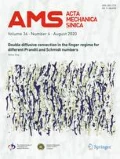Abstract
A homogenisation model for analysing the effect of micrometre pore sizes on the engineering moduli of elasticity of porous materials was proposed. In the proposed model, the engineering coefficients of localization of total strains (LTS coefficients) are considered instead of the classical strain localization tensors. For a pore, these coefficients represent the ratio of the sum of the strains in the volume of the pore to the sum of the strains in the volume of the porous body. To estimate the elastic moduli of a material with an arbitrary pore size, it is sufficient to have information about the elastic moduli and the LTS coefficient of a material with one basic pore size. Then, in Eshelby’s model of equivalent inclusion, a transition to LTS coefficient for material with arbitrary pore size is achieved, and its elasticity moduli are determined. The results for Young’s modulus of porous titanium, with different sizes of spherical pores, completely conform with the experimental data. We have obtained a model theoretic estimate of the upper bounds of Young’s modulus of porous materials with infinitely small pore size. For the spherical pores, the proposed assessment coincides with the upper limits of the Hashin–Shtrikman bounds.



Similar content being viewed by others
References
Gibson, L.J., Ashby, M.F.: Cellular Solids: Structures and Properties. Cambridge University Press, Cambridge (1999)
Hashin, Z.: Thermoelastic properties of particulate composites with imperfect interface. J. Mech. Phys. Solids 39, 745–762 (1991)
Zhong, Z., Meguid, S.A.: On the elastic field of a spherical inhomogeneity with an imperfectly bonded interface. J. Elasticity 46, 91–113 (1997)
Guo, J.G., Zhao, Y.P.: The surface- and size-dependent elastic moduli of nanostructures. Surf. Rev. Lett. 14, 667–670 (2007)
Wang, J., Duan, H.L., Zhang, Z., et al.: An anti-interpenetration model and connections between interphase and interface models in particle-reinforced composites. Int. J. Mech. Sci. 47, 701–708 (2005)
Duan, H.L., Yi, X., Huang, Z.P., et al.: A unified scheme for prediction of effective moduli of multiphase composites with interface effects. Part I: theoretical framework. Mech. Mater. 39, 81–93 (2007)
Wang, G.N., Chen, Q., He, Z.L., et al.: Homogenized moduli and local stress fields of unidirectional nanocomposites. Compos. Part B 138, 265–277 (2018)
Gurtin, M.E., Murdoch, A.I.: A continuum theory of elastic material surfaces. Arch. Ration. Mech. Anal. 57, 291–323 (1975)
Wang, K.F., Wang, B.L., Kitamura, T.: A review on the application of modified continuum models in modeling and simulation of nanostructures. Acta Mech. Sin. 31, 319–337 (2015)
Duan, H.L., Wang, J., Huang, Z.P., et al.: Size dependent effective elastic constants of solids containing nano-inhomogeneities with interface stress. J. Mech. Phys. Solids 53, 1574–1596 (2005)
Xu, W., Wu, Y., Gou, X.: Effective elastic moduli of nonspherical particle-reinforced composites with inhomogeneous interphase considering graded evolutions of elastic modulus and porosity. Comput. Methods Appl. Mech. Eng. 350, 535–553 (2019)
Duan, H.L., Wang, J., Karihaloo, B.L.: Theory of elasticity at the nanoscale. Adv. Appl. Mech. 42, 1–68 (2009)
Li, Y., Waas, A.M., Arruda, E.M.: A closed-form, hierarchical, multi-interphase model for composites—derivation, verification and application to nanocomposites. J. Mech. Phys. Solids 59, 43–63 (2011)
Xu, W., Wu, F., Jiao, Y., et al.: A general micromechanical framework of effective moduli for the design of nonspherical nano- and micro-particle reinforced composites with interface properties. Mater. Design 127, 162–172 (2017)
Duan, H.L., Wang, J., Karihaloo, B.L., et al.: Nanoporous materials can be made stiffer than non-porous counterparts by surface modification. Acta Mater. 54, 2983–2990 (2006)
Hill, R.: Elastic properties of reinforced solids: some theoretical principles. J. Mech. Phys. Solids 11, 357–372 (1963)
Qu, J., Cherkaoui, M.: Fundamentals of Micromechanics of Solids. Wiley, New Jersey (2006)
Ghossein, E., Lévesque, M.: A comprehensive validation of analytical homogenization models: the case of ellipsoidal particles reinforced composites. Mech. Mater. 75, 135–150 (2014)
Hashin, Z., Monteiro, P.J.M.: An inverse method to determine the elastic properties of the interphase between the aggregate and the cement paste. Cem. Concr. Res. 32, 1291–1300 (2002)
He, W., Han, M., Wang, S., et al.: Micromechanics of substrate-supported thin films. Acta Mech. Sin. 34, 381–391 (2018)
Eshelby, J.: The determination of the elastic field of an ellipsoidal inclusion and related problems. Proc. R. Soc. Lond. Ser. A Math. Phys. Sci. 241, 376–396 (1957)
Li, B.Q., Wang, C.Y., Lu, X.: Effect of pore structure on the compressive property of porous Ti produced by powder metallurgy technique. Mater. Design 50, 613–619 (2013)
Fedotov, A.: The hybrid homogenization model of elastic anisotropic porous materials. J. Mater. Sci. 53, 5092–5102 (2018)
Acknowledgements
This study was financially supported by the Russian Foundation for Basic Research (Grant 16-08-01183a).
Author information
Authors and Affiliations
Corresponding author
Rights and permissions
About this article
Cite this article
Fedotov, A.F. Model of homogenisation for analysing the effect of micrometre pore sizes on the elastic moduli of porous materials. Acta Mech. Sin. 35, 1060–1066 (2019). https://doi.org/10.1007/s10409-019-00881-y
Received:
Revised:
Accepted:
Published:
Issue Date:
DOI: https://doi.org/10.1007/s10409-019-00881-y




